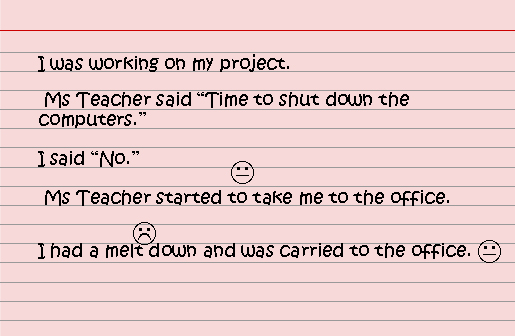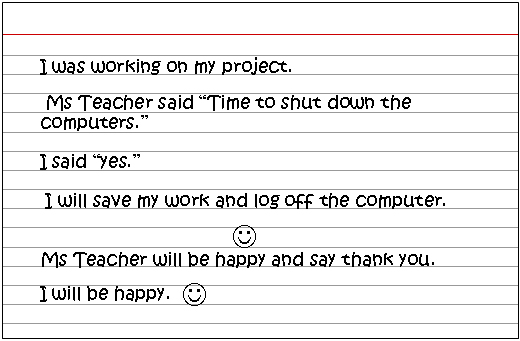|
Table of Contents
|

Teach students to be flexible and tolerate frustration
|
 |
S | – | Stop doing what you are doing |
 |
T | – | Think about something positive you should be doing |
 |
A | – | Act in a way that is appropriate for the situation or Ask for assistance |
 |
R | – | Reflect on what you have done; use self-talk to tell yourself, “Good job” |
or
Encourage students to use the SNAP acronym to remind themselves to use their problem-solving skills.
| S | – | Stop |
| N | – | Now |
| A | – | And |
| P | – | Plan |
Use social stories and scripts
Social stories and scripts help students prepare for what might happen in the future.
Social stories
Social stories are effective for students who require a high degree of structure to understand social expectations and interact successfully with others.10 They are simple stories that describe a social situation and how the student is expected to behave in that situation. They are especially effective with younger students and older students with developmental delays. Social stories combine language, routines and social expectations on a personal level. They guide and direct responding and can lead to increased self awareness and self-management. They provide a relevant, accurate orientation to a particular social context.
When developing social stories:
- identify a target behaviour or problem situation which has or may occur
- consider student’s developmental level and use vocabulary, print size and concepts appropriate for that student
- develop a specific step-by-step description of what the student needs to do in this situation
- consider what the student is currently doing in similar situations
- write a story using different types of sentences, including:
- descriptive sentences that describe the social situation and provide information
- directive sentences that suggest what the student is to do. To give flexibility they often are statements such as “I will try to …” rather than absolutes
- affirmative sentences that are somewhat abstract, but contain stress reducers such as “this is okay” which can reassure the student. They might also include phrases such as “This is important” to cue students that this particular rule must be followed
- perspective sentences that contain information about the internal states of other people. “My sister likes …”, “Some children like …”, “My mom is happy when …”
- cooperative statements that provide information about how the student can be assisted or supported. “My mom will help with …”
- write from the student’s point of view in present or future tense; e.g., “I will …”
- focus on one skill at a time
- use positive language
- answer “wh” questions, who, where, when, why, and how
- make the story concrete and literal
- use photos and pictures and, if possible, have students illustrate and/or co-write their own stories
- read and review the story with the student frequently and in different contexts
- teach the skill directly.
Social scripts
Like a movie script, a social script details a step-by-step process of what to do or say and what another person does or says. This technique can be used with students of all ages.
Use scripts to plan for positive behaviour, or to reflect on behaviour or a situation and choose a positive option. Try to ensure that the stories describe positive behaviour. For example:
“When I am working on math and my teacher says ‘Listen,’ I stop what I am doing, put down my pencil and look at her to show that I am listening.”
Social scripts can also provide information about how others might view or react to the situation. For example, “When I look at the teacher to show I am listening, she smiles back at me. She likes it when students follow her directions.”
Plan for new or exceptional circumstances such as school assemblies, class parties and other potentially stressful events by developing a step-by-step social script of what will happen, what the student will do and how others will react.
Another way of using social scripts is to write down four to ten actions a student has taken on file cards, along with how others reacted to these actions. Use a red card to record the student’s description of actions that have already occurred, and a white card to record the student’s ideas about what a more positive sequence of behaviours and reactions might be. This is an effective method of reviewing what the undesirable social behaviour was and the reaction it produced. This method also helps the student plan for more appropriate behaviour and its positive consequences.
Sample red card:

Sample white card:

Tips for using social scripts
- When introducing the concept, look for three to five examples of positive behaviour the student demonstrates and record these on a white card. Reinforce that students already have some of their own positive scripts.
- Relate this strategy to the way actors use scripts to create television shows and movies.
- Colour code the behavioural choices, using red cards for a step–by-step description of negative behaviour and white cards for a more positive script.
- After the student has written the second script on the white card, rehearse it with all the students involved. Physical practice and role-play is critical.
 |
Previous | Page 2 of 3 | Next page > |  |
| 10. | This section adapted with permission from Karen Bain (July 2007). |
